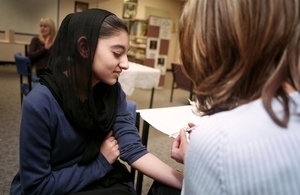New strategy for a measles and rubella free future
PHE makes recommendations on the steps needed to maintain the UK’s elimination status for measles and rubella for future generations.

The new measles and rubella elimination strategy maps out how the UK can achieve a future that is free of measles, rubella and congenital rubella syndrome (CRS).
The strategy, developed by Public Health England (PHE) and supported by partners across the NHS and the devolved administrations, builds on the experience and success of 50 years of measles vaccination and 30 years of the measles, mumps and rubella (MMR) immunisation programme.
Since the introduction of the measles vaccine, an estimated 20 million cases and 4,500 deaths have been prevented the UK. In addition, it is estimated that rubella vaccination has prevented an estimated 1.4 million cases of rubella, 1,300 CRS births, and averted 25,000 terminations. CRS is caused when rubella disrupts the development of an unborn baby, leading to serious birth defects.
However, new analysis conducted by PHE also shows that immunity levels within some age groups across the UK - especially young people aged 15 to 20 years - are well below the levels needed to prevent measles from spreading. Measles is one of the most infectious known diseases, so it can take only one infected person in an area with lower vaccination rates to cause an outbreak. Anyone who has not received 2 doses of MMR vaccine is at risk.
The World Health Organization (WHO) confirmed that the UK eliminated rubella in 2015 and measles in 2016. Elimination means that measles and rubella are no longer native to the UK. It does not mean that these diseases have been completely wiped out. Measles and rubella remain endemic in many countries around the world and with recent large measles outbreaks across Europe, imported infections pose a very real threat to the UK’s achievements.
In 2016 and 2017, uptake of the first dose of the MMR vaccine in 5 year olds in the UK exceeded 95% for the first time. However, 2 doses of MMR vaccine are required, to ensure full protection from measles. Uptake of the second dose of MMR in 5 year old children is currently 88% and well below the 95% WHO target required to sustain elimination going forward.
Dr Mary Ramsay, Head of Immunisation at PHE, said:
Our achievements to date are a testament to the hard work of health professionals in the NHS. But, if we wish to build on our successes, and sustain measles and rubella elimination for future generations action needs to be taken now.
A future free of measles and rubella is within reach if we continue to focus our efforts on reaching 95% uptake with 2 doses of MMR for all children and catch up teenagers and young adults who missed out.
The new strategy is clear that partners in the local health economy need to work together to continue to increase uptake of the MMR vaccine in all children, and address immunity gaps across the population by catching up teenagers and young adults who missed out on the vaccine when they were younger.
It includes a number of recommendations to maintain measles and rubella elimination going forward which cover 4 main areas:
- Achieve and sustain over 95% coverage with 2 doses of MMR vaccine in the routine childhood immunisation programme.
- Achieve over 95% coverage with 2 doses of MMR vaccine in older age groups.
- Strengthen measles and rubella monitoring.
- Ensure easy access to high-quality, evidence-based information for health professionals and the public.
The UK National Verification Committee (NVC) and all of the UK nations have independently assessed and endorsed the strategy, and have committed to implementing the recommendations.